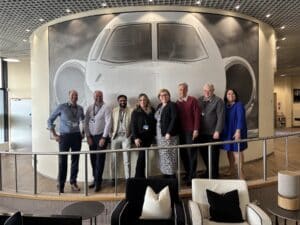The Foundation of Aerospace Compliance and Safety Management
Aerospace compliance management is integral to maintaining safety, reliability, and quality in all aerospace operations. It encompasses various regulations and standards set by global aviation authorities, including the EASA (European Union Aviation Safety Agency), FAA (Federal Aviation Administration), and ICAO (International Civil Aviation Organization).

Key Components of Aerospace Compliance Management
1. Safety Management Systems (SMS)
An SMS is a structured framework to improve safety performance by identifying, analyzing, and mitigating risks. It involves proactive hazard identification, risk assessment, and implementation of effective safety measures.
Core Elements of SMS:
- Safety Policy: Establishes senior management’s commitment to continuously improving safety; defines the methods, processes, and organizational structure needed to meet safety goals.
- Safety Risk Management: Identifies hazards, assesses risks, and implements risk controls.
- Safety Assurance: Evaluates the continued effectiveness of implemented risk control strategies and supports the identification of new hazards.
- Safety Promotion: Includes training, communication, and other actions to create a positive safety culture.
2. Management Systems (MS)
A Management System ensures that aerospace operations meet all applicable regulations and standards. It involves systematic planning, implementation, monitoring, and continuous improvement processes to maintain compliance.
Core Elements of Management Systems:
- Compliance Planning: Identifying relevant regulations and standards and determining how to satisfy them.
- Compliance Monitoring: Tracking and ensuring that operations meet regulatory requirements.
- Compliance Assurance: Verifying that compliance procedures are followed and effective.
- Compliance Improvement: Continuously enhancing compliance processes and standards.
3. Regulatory Compliance
Regulatory compliance involves adhering to laws and regulations that govern aerospace activities. These include aircraft maintenance, flight operations, crew qualifications, and environmental standards.
Key Regulations:
- EASA Regulations: Ensure uniform safety and environmental standards across the European Union.
- FAA Regulations: Cover all aspects of aviation, including aircraft design, manufacturing, operation, maintenance, and training.
- ICAO Standards: Facilitate global air navigation and standardize practices across international borders.
4. Environmental Compliance
Environmental compliance focuses on minimizing the aerospace industry’s environmental impact. This includes adhering to regulations on emissions, noise pollution, and sustainable resource management.
Key Areas:
- Emissions Control: Managing and reducing CO2 and other greenhouse gas emissions.
- Noise Reduction: Implementing technologies and practices to minimize noise pollution from aircraft operations.
- Sustainable Resource Management: Ensuring efficient use of resources and reducing waste.

Challenges in Aerospace Compliance Management
Managing compliance in the aerospace industry is fraught with challenges, stemming from the complexity and dynamism of regulations and the critical nature of safety and compliance standards.
Key Challenges:
1. Complex and Evolving Regulations
Aerospace regulations are detailed and frequently updated. Staying current with these changes requires continuous vigilance and adaptation.
Mitigation Strategies:
- Regulatory Monitoring: Use automated tools to track regulatory changes and updates.
- Expert Networks: Engage with industry experts and associations to stay informed about upcoming changes.
- Continuous Training: Regularly update training programs to reflect the latest regulations.
2. Data Management:
Aerospace operations generate extensive data, including maintenance records, flight logs, and safety reports. Effective compliance management necessitates robust data management systems.
Mitigation Strategies:
- Centralized Data Repositories: Implement centralized systems to store and manage compliance data.
- Data Analytics: Utilize advanced analytics to gain insights from compliance data and improve decision-making.
- Data Security: Ensure robust cybersecurity measures to protect sensitive compliance data.
3. Manual Processes
Traditional compliance management often relies on manual processes, which are time-consuming and error-prone. Automation and digitalization are critical to improving efficiency and accuracy.
Mitigation Strategies:
- Process Automation: Implement automated workflows for compliance processes.
- Digital Tools: Utilize digital compliance management tools to streamline operations.
- Error Reduction: Implement compliance checks and balances to minimize errors.
4. Human Error:
Human errors can have significant implications for compliance and safety. Ensuring accuracy and consistency in compliance activities is paramount.
Mitigation Strategies:
- Training Programs: Regularly train employees on compliance procedures and best practices.
- Error Reporting Systems: Encourage reporting of errors and near-misses to identify areas for improvement.
- Standard Operating Procedures (SOPs): Develop and maintain clear SOPs to guide compliance activities.

Best Practices for Effective Aerospace Compliance Management
Implementing best practices in compliance management can help organizations navigate regulatory complexities and enhance safety and compliance standards.
1. Implement Comprehensive Safety and Compliance Management Systems
Develop and maintain SMS and CMS frameworks aligned with industry standards and regulatory requirements. Ensure these systems include clear policies, procedures, and accountabilities for managing safety and compliance.
Action Steps:
- Gap Analysis: Conduct a gap analysis to identify areas needing improvement.
- Policy Development: Develop comprehensive safety and compliance policies.
- Performance Metrics: Establish metrics to monitor and evaluate performance.
2. Leverage Advanced Data Management Technologies
Utilize digital tools and automated systems for data collection, storage, and analysis. This reduces manual workload, minimizes errors, and enhances data accuracy.
Action Steps:
- Technology Assessment: Evaluate and select appropriate data management technologies.
- Integration: Ensure seamless integration of new technologies with existing systems.
- Training: Train staff on using new data management tools effectively.
3. Stay Informed About Regulatory Changes
Regularly monitor updates from aviation authorities and industry bodies. Implement processes to incorporate regulatory changes promptly into compliance activities.
Action Steps:
- Regulatory Alerts: Subscribe to regulatory alert services.
- Internal Communication: Establish channels for disseminating regulatory updates within the organization.
- Compliance Calendar: Maintain a compliance calendar to track important regulatory deadlines.
4. Conduct Regular Audits and Inspections:
Schedule and perform regular audits and inspections to assess compliance with regulations and internal standards. Use findings to identify improvement areas and implement corrective actions.
Action Steps:
- Audit Planning: Develop a comprehensive audit plan.
- Audit Execution: Use standardized checklists and tools to conduct audits.
- Follow-Up: Implement corrective actions based on audit findings and track progress.
5. Foster a Culture of Safety and Compliance
Promote a strong safety and compliance culture within the organization. Encourage open communication, continuous learning, and proactive reporting of safety concerns.
Action Steps:
- Leadership Commitment: Ensure senior management demonstrates commitment to safety and compliance.
- Employee Engagement: Involve employees in safety and compliance initiatives.
- Recognition Programs: Recognize and reward compliance achievements.
6. Provide Ongoing Training and Education
Ensure all personnel are trained on the latest regulations, standards, and best practices. Regular training sessions and educational resources help maintain high levels of competence and awareness.
Action Steps:
- Training Needs Analysis: Identify training needs through regular assessments.
- Training Programs: Develop and implement comprehensive training programs.
- Continuous Improvement: Continuously update training materials to reflect the latest industry developments.

Advanced Topics in Aerospace Compliance Management
To further deepen your understanding of aerospace compliance management, it’s essential to explore some advanced topics and emerging trends.
1. Risk-Based Oversight
Regulatory authorities are increasingly adopting risk-based oversight approaches. This involves focusing regulatory efforts on areas with the highest risk, improving safety outcomes through targeted interventions.
Key Concepts:
- Risk Assessment: Identify and assess risks to prioritize oversight activities.
- Risk Mitigation Strategies: Develop strategies to mitigate identified risks.
- Performance Monitoring: Continuously monitor and evaluate the effectiveness of risk mitigation measures.
2. Performance-Based Regulations
Performance-based regulations offer flexibility by allowing organizations to achieve regulatory objectives through innovative means. This approach emphasizes outcomes rather than prescriptive processes, encouraging continuous improvement.
Key Concepts:
- Outcome Focus: Define clear performance outcomes and objectives.
- Innovative Approaches: Encourage the use of innovative methods to achieve compliance.
- Continuous Monitoring: Monitor performance outcomes to ensure compliance.
3. Digital Transformation
The aerospace industry is undergoing a digital transformation, with advanced technologies such as AI, machine learning, and IoT playing crucial roles in compliance management. These technologies enhance data analytics, predictive maintenance, and real-time monitoring capabilities.
Key Concepts:
- AI and Machine Learning: Use AI and machine learning for predictive analytics and automated decision-making.
- IoT: Implement IoT devices for real-time monitoring of compliance-related data.
- Digital Twins: Use digital twin technology to simulate and optimize compliance processes.
4. Sustainability and Green Aviation
Environmental compliance is becoming increasingly important as the industry focuses on sustainability and green aviation initiatives. This includes adopting cleaner technologies, reducing emissions, and enhancing resource efficiency.
Key Concepts:
- Sustainable Aviation Fuels (SAF): Promote the use of SAF to reduce carbon emissions.
- Energy Efficiency: Implement energy-efficient technologies and practices.
- Waste Management: Develop comprehensive waste management strategies to minimize environmental impact.

Real-World Applications and Benefits
Understanding the practical applications and benefits of effective compliance management can provide valuable insights and drive home the importance of these practices.
1. Risk Mitigation
Effective compliance management helps mitigate risks associated with safety incidents and regulatory violations, protecting passengers, crew, and the organization’s reputation. For example, implementing a robust incident response plan that complies with regulatory requirements can prevent minor issues from escalating into major incidents.
2. Operational Efficiency
Streamlined compliance processes improve operational efficiency by reducing downtime and minimizing disruptions. This leads to cost savings and more reliable service delivery. Predictive maintenance techniques can optimize maintenance activities, reducing aircraft downtime and improving overall efficiency.
3. Regulatory Assurance
Robust compliance management provides assurance to regulatory authorities, resulting in smoother audits and inspections and potentially fewer regulatory interventions. Comprehensive audit preparation processes ensure all documentation and processes are in compliance with regulations, making regulatory interactions more efficient.
4. Enhanced Safety Performance
A strong focus on compliance and safety management leads to improved safety performance, including lower incident rates, better hazard identification, and more effective risk management. Encouraging a culture of safety reporting where employees feel comfortable reporting hazards and near-misses can lead to proactive risk management and a safer operational environment.

Conclusion
Aerospace compliance management is a critical aspect of ensuring safety and reliability, and quality in the industry. By understanding its components, challenges, and best practices, organizations can develop robust systems that meet regulatory requirements and enhance overall safety performance. Whether you are new to the industry or looking to deepen your expertise, embracing a proactive approach to compliance management will position your organization for success.
At AMAS.aero, we offer cutting-edge solutions designed to simplify and enhance aerospace compliance management. Our platform leverages advanced technology to provide real-time updates, automated intelligence, and comprehensive safety and compliance management tools. Experience the benefits of streamlined compliance processes, reduced risks, and improved operational efficiency.
Take the next step in revolutionizing your aerospace compliance management. Visit AMAS.aero to learn more about our innovative solutions and request a demo today!
For further reading and resources on aerospace compliance management, explore detailed guides and educational materials available on the AMAS.aero platform. Stay informed, leverage advanced tools and technologies, and ensure your compliance activities are efficient, effective, and aligned with industry best practices.




